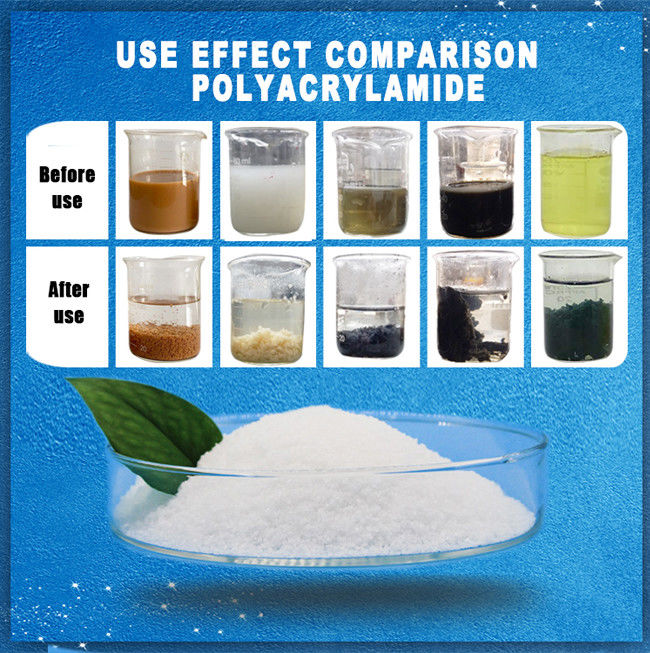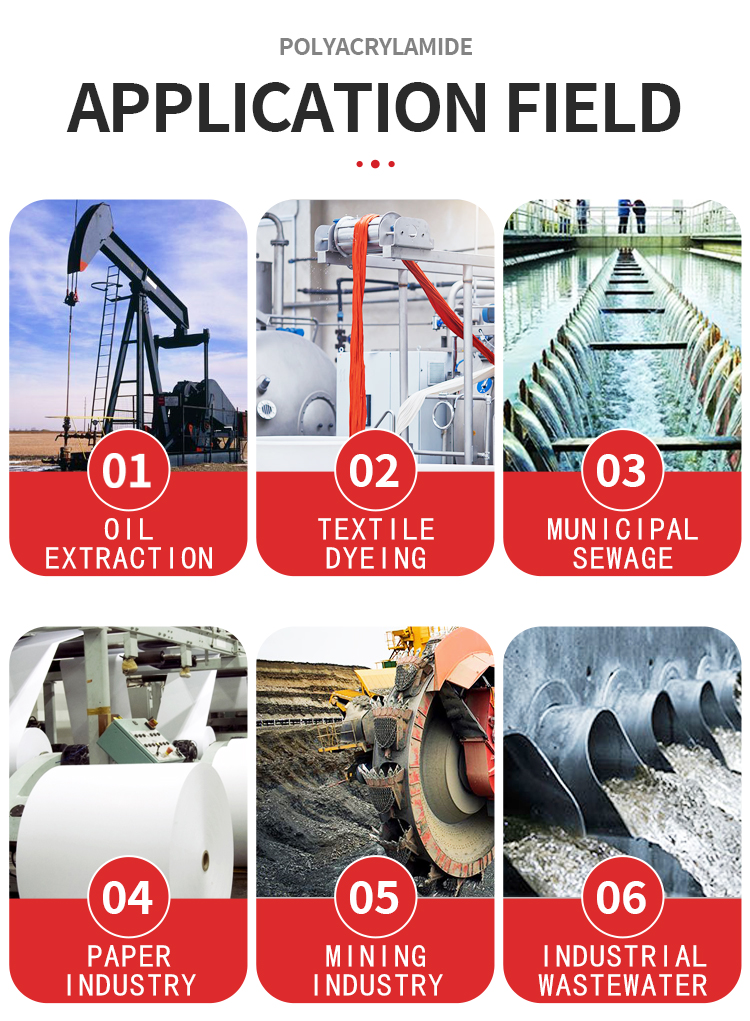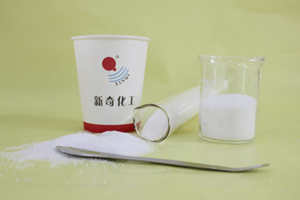
Product Description:
Polyacrylamide (PAM) is one of the most widely used varieties of water-soluble polymers. It is divided into cationic polyacrylamide, anionic polyacrylamide and nonionic polyacrylamide. Because the structural unit of polyacrylamide contains amide groups, it is easy to form hydrogen bonds, which makes it have good water solubility and high chemical activity, and it is easy to obtain various modifications of branched chain or network structure through grafting or crosslinking. It is widely used in petroleum exploration, water treatment, textile, papermaking, mineral processing, medicine, agriculture and other industries, and is known as “auxiliaries for all industries”. The main application fields in foreign countries are water treatment, papermaking, mining, metallurgy, etc.; in China, the largest amount is currently used in the field of oil extraction, and the fastest growing fields are in the fields of water treatment and papermaking.
During use, it is sometimes used together with PAC(industrial grade brown granule, industrial grade yellow granule, drinking grade yellowish powder, drinking grade white powder), PFS and other water treatment chemicals.
Application Fields:
Ⅰ. Water Treatment Fields:
Water treatment includes raw water treatment, sewage treatment and industrial water treatment. Used in conjunction with activated carbon in raw water treatment, it can be used for coagulation and clarification of suspended particles in domestic water. The use of organic flocculant acrylamide instead of inorganic flocculant can increase the water purification capacity by more than 20% even without modifying the settling tank; in sewage treatment, the use of polyacrylamide can increase the utilization rate of water recycling and can also be used as Sludge dewatering; used as an important formulation agent in industrial water treatment. The largest field of application of polyacrylamide abroad is water treatment, and the application in this field in China is being promoted. The main role of polyacrylamide in water treatment:
①Reduce the amount of flocculant. Under the premise of achieving the same water quality, polyacrylamide is used as a coagulation aid in combination with other flocculants, which can greatly reduce the amount of flocculants used;
② Improve water quality. In drinking water treatment and industrial wastewater treatment, the use of polyacrylamide in combination with inorganic flocculants can significantly improve water quality;
③Increase floc strength and settling velocity. The flocs formed by polyacrylamide have high strength and good settling performance, thereby increasing the solid-liquid separation speed and facilitating sludge dewatering;
④ Anti-corrosion and anti-scaling of circulating cooling system. The use of polyacrylamide can greatly reduce the amount of inorganic flocculants, thereby avoiding the deposition of inorganic substances on the surface of equipment, and slowing down the corrosion and scaling of equipment.
Ⅱ. Applications In Oil Recovery:
Polyacrylamide is a kind of multifunctional oilfield chemical treatment agent, which is widely used in drilling, cementing, completion, workover, fracturing, acidizing, water injection, water plugging and profile control, and tertiary oil recovery operations in oil production. It is in the fields of drilling, water plugging and profile control and tertiary oil recovery. Polyacrylamide aqueous solution has high viscosity, good thickening, flocculation and rheological adjustment, and is used as oil displacement agent and drilling mud conditioner in oil production. In the middle and late stages of oil exploitation, in order to enhance oil recovery, my country currently mainly promotes polymer flooding and ASP flooding technologies. By injecting polyacrylamide aqueous solution, the oil-water flow rate ratio is improved to increase the crude oil content in the produced product. Adding polyacrylamide in tertiary oil recovery can increase oil displacement capacity, avoid breakdown of oil layers, and increase oil bed recovery yield. China’s petroleum industry is the largest user of polyacrylamide. The scientific and technological progress of polyacrylamide has promoted the development of China’s petroleum industry, and the demand of the petroleum industry has accelerated the pace of scientific and technological innovation of polyacrylamide and the development of the industry.
Ⅲ. Paper Fields:
Polyacrylamide is widely used as retention aid, filter aid, and leveling agent in the field of papermaking to improve paper quality, slurry dehydration performance, retention rate of fine fibers and fillers, reduce raw material consumption and environmental pollution, Used as a dispersant to improve the uniformity of paper. Polyacrylamide is mainly used in two aspects in the paper industry. One is to increase the retention rate of fillers and pigments to reduce the loss of raw materials and environmental pollution; the other is to increase the strength of paper. Adding polyacrylamide to the paper material can increase the retention rate of fine fibers and filler particles on the net and accelerate the dehydration of the paper material. The mechanism of action of polyacrylamide is that the particles in the slurry are flocculated and retained on the filter cloth by neutralization or bridging. The formation of flocs can also make the water in the slurry easier to filter out, reduce the loss of fibers in white water, reduce environmental pollution, and help improve the efficiency of filtration and sedimentation equipment.
Ⅳ. Other Industries:
In the food industry, it is used for cane juice clarification and syrup phosphorus floatation extraction in the production of cane sugar and beet sugar. Enzyme fermentation liquid flocculation and clarification industry, also used for the recovery of feed protein, stable quality, good performance, the recovered protein powder has no adverse effects on the survival rate of chickens, weight gain, egg production, synthetic resin coatings, civil engineering grouting materials plugging Water, building materials industry, improvement of cement quality, construction industry adhesives, joint repair and water blocking agent, soil improvement, electroplating industry, printing and dyeing industry, etc.


